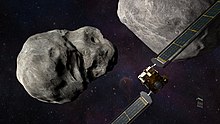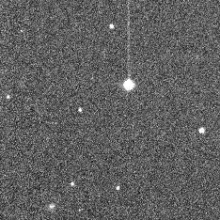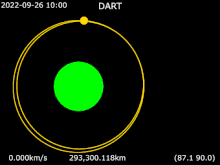65803 Didymos
 | |
| Discovery [1] | |
|---|---|
| Discovered by | Spacewatch |
| Discovery site | Kitt Peak National Observatory |
| Discovery date | 11 April 1996 |
| Designations | |
| (65803) Didymos | |
| Pronunciation | /ˈdɪdɪmɒs/[2] |
Named after | Greek word for "Twin"[3] |
| 1996 GT | |
| NEO · PHA Apollo (2022) [1][a] | |
| Orbital characteristics [1] | |
| Epoch 21 January 2022 (JD 2459600.5) | |
| Uncertainty parameter 0 | |
| Observation arc | 24.82 years (9,066 days) |
| Aphelion | 2.2753 AU |
| Perihelion | 1.0131 AU |
| 1.6442 AU | |
| Eccentricity | 0.38385 |
| 2.11 yr (770 days) | |
| 232.01 | |
| 0° 28m 2.28s / day | |
| Inclination | 3.4079° |
| 73.196° | |
| 319.32° | |
| Known satellites | 1 (Dimorphos) |
| Earth MOID | 0.0403 AU (15.7 LD) |
| Mars MOID | 0.02 AU (7.8 LD)[4] |
| Physical characteristics[5] | |
| Dimensions | 851 × 849 × 620 m (± 15 × 15 × 15 m) |
| 765±15 m[b] | |
| Mass | (5.4±0.4)×1011 kg (system)[6] ≈ 5.2×1011 kg (primary)[7] |
Mean density | 2.40±0.30 g/cm3[5] |
| 2.2600±0.0001[6] 2.2593±0.0002 h[8] | |
| 174°±20°[c] | |
Pole ecliptic latitude | −84°±20° |
Pole ecliptic longitude | 310°±20° |
| 0.15±0.04 | |
| S[6][10] · SMASS = Xk[1] · X[11] | |
| 18.0[1] · 18.16[11][8][12] 18.16±0.03[13] | |
65803 Didymos (provisional designation 1996 GT) is a sub-kilometer asteroid and binary system that is classified as a potentially hazardous asteroid and near-Earth object of the Apollo group.[a] The asteroid was discovered in 1996 by the Spacewatch survey at Kitt Peak, and its small 160-meter minor-planet moon, named Dimorphos, was discovered in 2003. Due to its binary nature, the asteroid was then named Didymos, the Greek word for 'twin'.
Didymos's moon, Dimorphos, was the target of the DART mission to test the viability of asteroid impact avoidance by collision with a spacecraft, while the impact was witnessed by LICIACube, a flyby CubeSat component of the mission.
Discovery
[edit]
Didymos was discovered on 11 April 1996 by the University of Arizona Steward Observatory's, and Lunar and Planetary Laboratory's, Spacewatch survey using its 0.9-meter telescope at Kitt Peak National Observatory in Arizona, United States. The binary nature of the asteroid was discovered by others; suspicions of binarity first arose in Goldstone delay-Doppler echoes, and these were confirmed with an optical lightcurve analysis, along with Arecibo radar imaging on 23 November 2003.[4]
Orbital characteristics
[edit]Didymos orbits the Sun at a distance of 1.0–2.3 AU once every 770 days (2 years and 1 month). Its orbit has an eccentricity of 0.38 and an inclination of 3° with respect to the ecliptic. The minimum distance between the orbit of Earth and the orbit of Didymos is currently 0.04 AU (6.0 million km),[1] but will change as the asteroid is perturbed. In November 2003 it passed 7.18 million km from Earth; it will not come that near again until November 2123, with a distance of 5.86 million km. Didymos also occasionally passes very close to Mars: it will fly by Mars at a distance of 4.68 million km in July 2144.[1] Even the Earth approach of October 2184 is still listed with an uncertainty region of roughly ±1343 km.[14]
Didymos spends 1/3 of its time orbiting in the near-Earth asteroid (NEA) region where impacts are more probable. This means that about every 73–84 thousand years, an object impacts Didymos with the energy of the DART mission satellite. Over its median NEA lifetime of 8 to 10 million years, Didymos probably has been impacted tens of times.[15]
Physical characteristics
[edit]

In the SMASS classification, Didymos was classified as an Xk-type asteroid, which transitions from the X-type to the rare K-type asteroids.[1] Subsequent visible and near-infrared spectroscopy showed it to be silicate in nature, which also qualifies it as a stony S-type asteroid.[16] It rotates rapidly, with a period of 2.26 hours and a low brightness variation of 0.08 magnitude (U=3/3), which indicates that the body has a nearly spheroidal shape.[11][8][17] Radar observations confirmed this spheroidal shape, showing it to be oblate due to its rapid rotation.[6]
Satellite
[edit]Didymos is a binary asteroid with a satellite in its orbit. The minor-planet moon, named Dimorphos,[18] moves in a mostly circular retrograde orbit[19] with an orbital period of 11.9 hours.[11][d] It measures approximately 160 meters (520 ft) in diameter compared to 780 meters (2,560 ft) for its primary (a mean diameter-ratio of 0.22).[20] It was previously known by its provisional designation S/2003 (65803) 1 and had been informally called "Didymoon" or "Didymos B".[21][18]
Naming
[edit]This minor planet was named "Didymos", Greek for "twin", due to its binary nature.[3] The name was suggested by the discoverer, University of Arizona Lunar and Planetary Laboratory astronomer Joseph L. "Joe" Montani, who made the naming proposal to the International Astronomical Union after the binary nature of the object was detected. The approved naming citation was published on 13 July 2004 (M.P.C. 52326).[22]
The proper name for the satellite Didymos B comes from the word "Dimorphos", Greek for "having two forms".[23] The meaning of the name represents how the form of Dimorphos's orbit will change after the collision with NASA’s Double Asteroid Redirection Test (DART) spacecraft,[18] though in fact the change will be only a very slight change in its orbital parameters. Appropriately, Dimorphos serves dual roles as both a test target and as a part of a blueprint for a modality for future planetary protection.[18] The name of the moon was suggested by planetary scientist Kleomenis Tsiganis at the Aristotle University of Thessaloniki, Greece.[24]
Two boulders (saxa) have been given names of traditional drums.[25]
| Name | Pronunciation | Feature | Named after | Date approved[25] |
|---|---|---|---|---|
| Carillon Saxum | US: /ˈkærəlɒn/ UK: /kəˈrɪljən/ |
boulder | carillon | 14 Nov 2023 |
| Gong Saxum | /ˈɡɒŋ/ | boulder | gong | 14 Nov 2023 |
Exploration
[edit]



DART · 65803 Didymos · Earth · Sun · 2001 CB21 · 3361 Orpheus

DART · Didymos · Dimorphos
In the early 2010s, Didymos's moon, Dimorphos was to be the principal target of proposed robotic mission by the ESA and NASA, called the Asteroid Impact & Deflection Assessment (AIDA) mission. The ESA dropped out, and the mission did not proceed.[26][27]
NASA redefined mission requirements and decided to proceed with a 2020s mission to visit Didymos with an impactor, which had been considered as a part of the earlier AIDA mission, named the Double Asteroid Redirection Test or DART. The NASA mission was intended to test whether a spacecraft impact could successfully deflect an asteroid on a collision course with Earth. The DART spacecraft was launched on 24 November 2021, and impacted Dimorphos on September 26, 2022.[28][29][30] It was accompanied by the Italian Space Agency's (ASI) six-unit LICIACube flyby Cubesat that was released 15 days before impact to observe the asteroid and DART's impact.[31]
DART was the first spacecraft to intentionally target and successfully visit an asteroid known to have a minor-planet moon (The binary asteroid 2000 DP107 was targeted by the PROCYON mission before it failed, 243 Ida was visited by the Galileo spacecraft but its moon was unknown until then, Pluto was considered a planet until a few months after the launch of New Horizons, and 3548 Eurybates's and 15094 Polymele's moons were not discovered until months before and after Lucy's launch, respectively). Didymos is the most easily reachable asteroid of its size from Earth, requiring a delta-v of only 5.1 km/s for a spacecraft to rendezvous, compared to 6.0 km/s to reach the Moon.[32]
After two weeks of analysis, NASA announced that the collision shortened Dimorphos's orbital period around Didymos by 32 minutes,[33] far more than the minimum requirement of 73 seconds and the success benchmark of 10 minutes. The measurement has an uncertainty of ±2 minutes.[34]

Another mission to Didymos was approved in November 2019 and launched in October 2024, with the arrival at Didymos being expected in 2026.[35] ESA's Hera mission is planning to survey the dynamical effects of the DART impact and measure the characteristics of the crater made by DART.[36]
See also
[edit]- 66391 Moshup – a similar near-Earth asteroid binary system
- List of asteroids visited by spacecraft
Notes
[edit]- ^ a b It is an Apollo asteroid because perihelion (q) is less than 1.017 AU (Earth aphelion), not greater.
- ^ Volume-equivalent spherical diameter is calculated from an ellipsoid's volume given Didymos's dimensions of 851 × 849 × 620 m,[5]: 28–29 and then solving for radius with .
- ^ Naidu et al. (2020) give the Didymos's north pole direction in terms of ecliptic coordinates, where λ is ecliptic longitude and β is ecliptic latitude.[6]: 12 β is the angular offset from the ecliptic plane whereas inclination i with respect to the ecliptic is the angular offset from the ecliptic north pole at β = +90°; i with respect to the ecliptic would be the complement of β.[9] Therefore, given β = –84°, i = 90° – (–84°) = 174° from the ecliptic.
- ^ Lightcurve plots of 65803 Didymos, Palmer Divide Observatory, B. D. Warner
References
[edit]- ^ a b c d e f g h "JPL Small-Body Database Browser: 65803 Didymos (1996 GT)" (2017-04-27 last obs.). Jet Propulsion Laboratory. Archived from the original on 22 April 2021. Retrieved 28 June 2017.
 This article incorporates text from this source, which is in the public domain.
This article incorporates text from this source, which is in the public domain.
- ^ "didymous". Oxford English Dictionary (Online ed.). Oxford University Press. (Subscription or participating institution membership required.)
- ^ a b Schmadel, Lutz D. (2006). "(65803) Didymos [1.64, 0.38, 3.4]". Dictionary of Minor Planet Names – (65803) Didymos, Addendum to Fifth Edition: 2003–2005. Springer Berlin Heidelberg. p. 225. doi:10.1007/978-3-540-34361-5_2677. ISBN 978-3-540-34361-5.
- ^ a b "65803 Didymos (1996 GT)". Minor Planet Center. Archived from the original on 12 November 2020. Retrieved 12 March 2017.
- ^ a b c Cheng, Andrew; Agrusa, Harrison; Barbee, Brent; Meyer, Alex; Farnham, Tony; Raducan, Sabina; et al. (December 2022). "Momentum Transfer from the DART Mission Kinetic Impact on Asteroid Dimorphos" (PDF). Research Square. doi:10.21203/rs.3.rs-2339073/v1. (This work is licensed under a CC BY 4.0 License)
- ^ a b c d e Naidu, S. P.; Benner, L. A. M.; Brozovic, M.; Nolan, M. C.; Ostro, S. J.; Margot, J. L.; et al. (September 2020). "Radar observations and a physical model of binary near-Earth asteroid 65803 Didymos, target of the DART mission" (PDF). Icarus. 348: 113777. Bibcode:2020Icar..34813777N. doi:10.1016/j.icarus.2020.113777. S2CID 219091858. 134777.
- ^ Nakano, Ryota; Hirabayashi, Masatoshi; Brozovic, M.; Nolan, M. C.; Ostro, S. J.; Margot, J. L.; et al. (July 2022). "NASA's Double Asteroid Redirection Test (DART): Mutual Orbital Period Change Due to Reshaping in the Near-Earth Binary Asteroid System (65803) Didymos". The Planetary Science Journal. 3 (7): 16. Bibcode:2022PSJ.....3..148N. doi:10.3847/PSJ/ac7566. S2CID 250327233. 148.
- ^ a b c Pravec, P.; Scheirich, P.; Kusnirák, P.; Sarounová, L.; Mottola, S.; Hahn, G.; et al. (March 2006). "Photometric survey of binary near-Earth asteroids". Icarus. 181 (1): 63–93. Bibcode:2006Icar..181...63P. doi:10.1016/j.icarus.2005.10.014. Archived from the original on 3 October 2022. Retrieved 12 March 2017.
- ^ "Coordinate transformations". Astronomy and Astrophysics. European Southern Observatory. January 1998. Archived from the original on 17 June 2021. Retrieved 17 June 2022.
- ^ Scheirich, P.; Pravec, P. (July 2022). "Preimpact Mutual Orbit of the DART Target Binary Asteroid (65803) Didymos Derived from Observations of Mutual Events in 2003–2021". The Planetary Science Journal. 3 (7): 12. Bibcode:2022PSJ.....3..163S. doi:10.3847/PSJ/ac7233. S2CID 250650906. 163.
- ^ a b c d "LCDB Data for (65803) Didymos". Asteroid Lightcurve Database (LCDB). Archived from the original on 1 July 2020. Retrieved 12 March 2017.
- ^ Kitazato, K.; Abe, M.; Mito, H.; Tarusawa, K.; Soyano, T.; Nishihara, S.; et al. (March 2004). "Photometric Behaviour Dependent on Solar Phase Angle and Physical Characteristics of Binary Near-Earth-Asteroid (65803) 1996 GT". 35th Lunar and Planetary Science Conference. p. 1623. Bibcode:2004LPI....35.1623K. Archived from the original on 3 October 2022. Retrieved 12 March 2017.
- ^ Pravec, Petr; Harris, Alan W.; Kusnirák, Peter; Galád, Adrián; Hornoch, Kamil (September 2012). "Absolute magnitudes of asteroids and a revision of asteroid albedo estimates from WISE thermal observations". Icarus. 221 (1): 365–387. Bibcode:2012Icar..221..365P. doi:10.1016/j.icarus.2012.07.026. Retrieved 12 March 2017.
- ^ "Horizons Batch for 2184-Oct-14 Close Approach". JPL Horizons. Archived from the original on 15 October 2022. Retrieved 14 October 2022. RNG_3sigma = uncertainty range in km. (JPL#194/Soln.date: 2022-Oct-13 generates RNG_3sigma = 1343 km)
- ^ Campo Bagatin, Adriano; Dell’Oro, Aldo; Parro, Laura M.; Benavidez, Paula G.; Jacobson, Seth; Lucchetti, Alice; Marzari, Francesco; Michel, Patrick; Pajola, Maurizio; Vincent, Jean-Baptiste (3 May 2024). "Recent collisional history of (65803) Didymos". Nature Communications. 15 (1): 3714. Bibcode:2024NatCo..15.3714C. doi:10.1038/s41467-024-48094-7. ISSN 2041-1723. PMC 11068898. PMID 38702317.
- ^ de León, J.; Licandro, J.; Serra-Ricart, M.; Pinilla-Alonso, N.; Campins, H. (28 July 2010). "Observations, compositional, and physical characterization of near-Earth and Mars-crosser asteroids from a spectroscopic survey". Astronomy and Astrophysics. 517: A23. Bibcode:2010A&A...517A..23D. doi:10.1051/0004-6361/200913852.
- ^ Pravec, P.; Benner, L. A. M.; Nolan, M. C.; Kusnirak, P.; Pray, D.; Giorgini, J. D.; et al. (November 2003). "(65803) 1996 GT". IAU Circular. 8244 (8244): 2. Bibcode:2003IAUC.8244....2P. Archived from the original on 3 October 2022. Retrieved 12 March 2017.
- ^ a b c d Talbert, Tricia (23 June 2020). "NASA's First Planetary Defense Mission Target Gets a New Name". NASA. Archived from the original on 10 February 2021. Retrieved 23 June 2020.
 This article incorporates text from this source, which is in the public domain.
This article incorporates text from this source, which is in the public domain.
- ^ Scheirich, P.; Pravec, P.; Jacobson, S.A.; Ďurech, J.; Kušnirák, P.; Hornoch, K.; Mottola, S.; Mommert, M.; Hellmich, S.; Pray, D.; Polishook, D.; Krugly, Yu.N.; Inasaridze, R.Ya.; Kvaratskhelia, O.I.; Ayvazian, V.; Slyusarev, I.; Pittichová, J.; Jehin, E.; Manfroid, J.; Gillon, M.; Galád, A.; Pollock, J.; Licandro, J.; Alí-Lagoa, V.; Brinsfield, J.; Molotov, I.E. (2015). "The binary near-Earth Asteroid (175706) 1996 FG3 — an observational constraint on its orbital evolution". Icarus. 245: 56–63. arXiv:1406.4677. Bibcode:2015Icar..245...56S. doi:10.1016/j.icarus.2014.09.023. S2CID 119248574.
- ^ Johnston, Robert (20 September 2014). "(65803) Didymos". johnstonsarchive.net. Archived from the original on 23 October 2020. Retrieved 28 June 2017.
- ^ "Telescopes focus on target of ESA's asteroid mission Archived 18 August 2015 at the Wayback Machine" at phys.org (30 June 2015)
- ^ "MPC/MPO/MPS Archive". Minor Planet Center. Archived from the original on 7 January 2022. Retrieved 12 March 2017.
- ^ "MPEC 2020-M83 : (65803) Didymos I = Dimorphos". Minor Planet Center. International Astronomical Union. 23 June 2020. Archived from the original on 8 October 2021. Retrieved 23 June 2020.
- ^ "IAU Approves Name of Target of First NASA and ESA Planetary Defence Missions". International Astronomical Union. 23 June 2020. Archived from the original on 26 September 2021. Retrieved 23 June 2020.
- ^ a b "Nomenclature Search Results". planetarynames.wr.usgs.gov.
- ^ "AIDA: Asteroid Impact and Deflection Assessment mission under study at ESA and NASA" (PDF). Observatoire de la Côte d'Azur. February 2015. Archived (PDF) from the original on 14 October 2016. Retrieved 28 June 2017.
- ^ "Asteroid Impact & Deflection Assessment". ESA. Archived from the original on 19 March 2018. Retrieved 28 June 2017.
- ^ Warren, Haygen (26 September 2022). "Brace for impact: DART successfully slams into asteroid". NASASpaceFlight.com. Archived from the original on 27 September 2022. Retrieved 27 September 2022.
- ^ "DART Sets Sights on Asteroid Target". NASA. 7 September 2022. Archived from the original on 21 September 2022. Retrieved 20 September 2022.
- ^ Potter, Sean (23 November 2021). "NASA, SpaceX Launch DART: First Test Mission to Defend Planet Earth". NASA. Archived from the original on 24 November 2021. Retrieved 25 November 2021.
- ^ Greshko, Michael (23 November 2021). "This NASA spacecraft will smash into an asteroid—to practice saving Earth". National Geographic. Archived from the original on 23 November 2021. Retrieved 25 November 2021.
- ^ "Delta-v for spacecraft rendezvous with all known near-Earth asteroids". 2010. Archived from the original on 3 June 2001. Retrieved 7 October 2010.
- ^ "NASA says DART's asteroid impact was a huge success". The Planetary Society. Retrieved 11 October 2022.
- ^ "NASA Confirms DART Mission Impact Changed Asteroid's Motion in Space". NASA. 11 October 2022. Retrieved 11 October 2022.
- ^ "Planetary defence mission Hera heading for deflected asteroid". www.esa.int. Retrieved 7 October 2024.
- ^ Numerical modelling of the DART impact and the importance of the Hera mission. Sabina D. Raducan, Thomas M. Davison, Gareth S. Collins. PDC 2019. Washington, D.C., USA.
External links
[edit]- Asteroids with Satellites, Robert Johnston, johnstonsarchive.net
- Discovery Circumstances: Numbered Minor Planets (65001)-(70000) – Minor Planet Center
- 65803 Didymos at NeoDyS-2, Near Earth Objects—Dynamic Site
- 65803 Didymos at the JPL Small-Body Database

![{\displaystyle r={\sqrt[{3}]{3V \over 4\pi }}}](https://wikimedia.org/api/rest_v1/media/math/render/svg/0433b06fed29a77aa4be9b21c2fb831b441da220)

